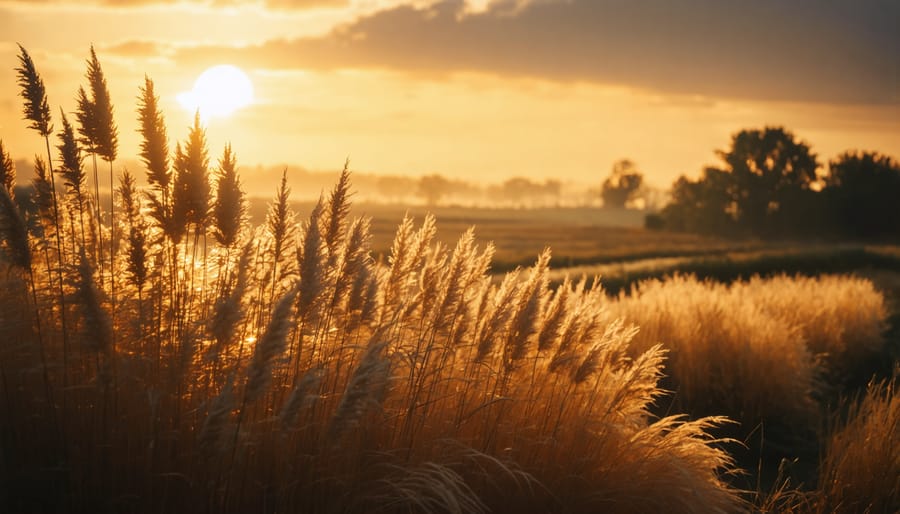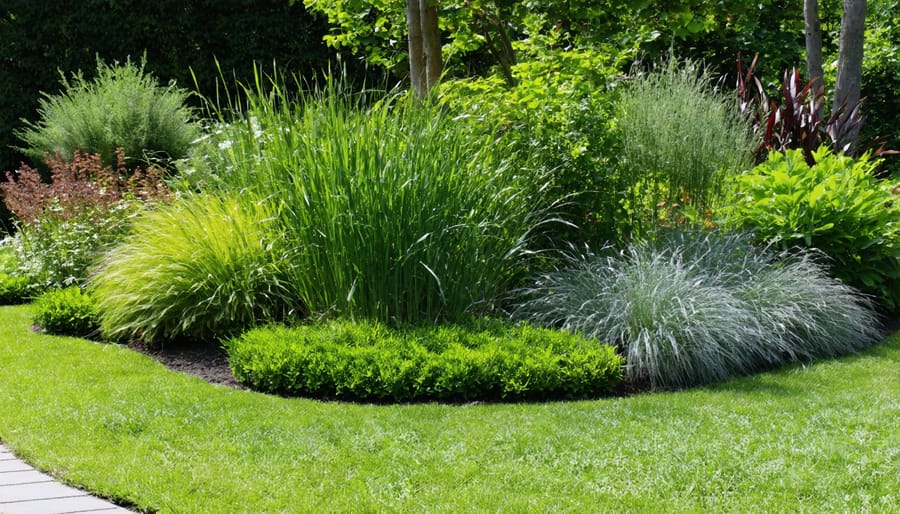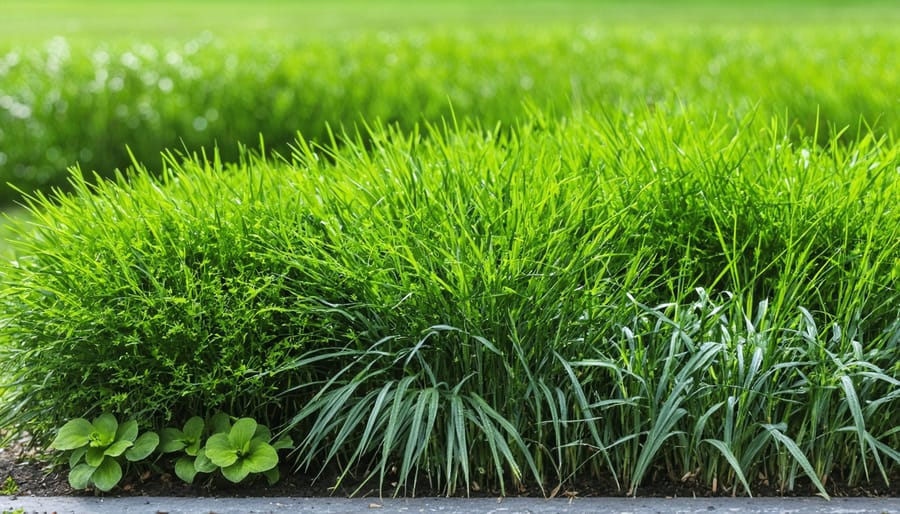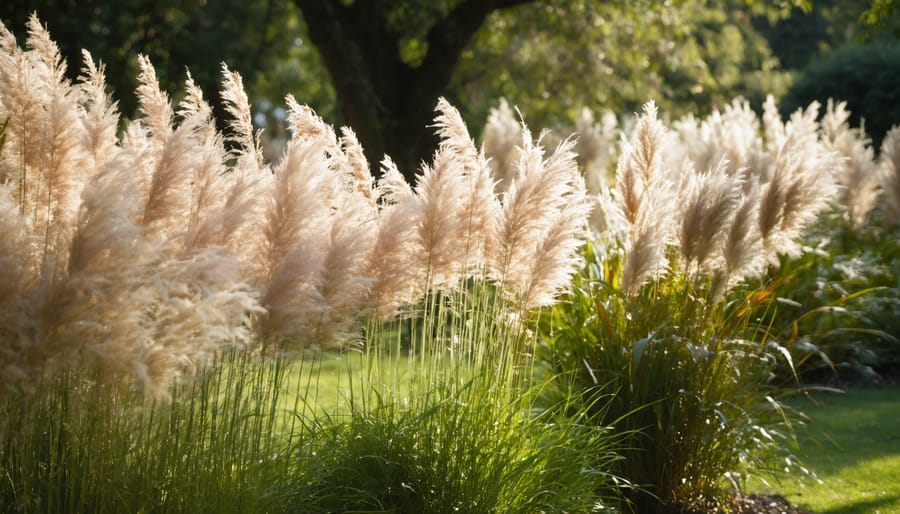Transform your garden into a living masterpiece with ornamental flowering grasses, nature’s most versatile and dramatic performers. These graceful plants dance in the breeze, catch light like prisms at dawn, and provide year-round visual interest with their striking seed heads and winter silhouettes. From the towering plumes of Feather Reed Grass to the delicate pink mist of Muhly Grass, these low-maintenance showstoppers offer something few other plants can match: movement, sound, and ever-changing beauty through all four seasons.
Modern gardeners have discovered what landscape designers have long known – ornamental grasses create spectacular focal points, soften hardscapes, and bring natural rhythm to any garden space. Whether used as living screens, mass plantings, or container specimens, these architectural plants blend effortlessly with perennials while requiring minimal water and care. Their ability to thrive in challenging conditions, from drought-prone slopes to rain gardens, makes them invaluable tools for sustainable landscape design.
As we explore the world of ornamental grasses, you’ll discover how these remarkable plants can revolutionize your outdoor space while supporting local wildlife and reducing garden maintenance time.
Top Ornamental Grasses for Every Garden Style
Tall and Dramatic Varieties
For gardeners seeking to make a bold statement, tall ornamental grasses offer unmatched drama and vertical interest. Miscanthus sinensis, commonly known as maiden grass, stands as a perfect example, reaching impressive heights of 6-8 feet with feathery plumes that catch the light beautifully at sunset. Its cultivars, like the popular ‘Morning Light’ and ‘Gracillimus,’ add year-round structure to garden borders.
Pampas grass (Cortaderia selloana) commands attention with its magnificent white plumes soaring up to 12 feet high. While stunning, gardeners should plant it thoughtfully as it can spread vigorously in some regions. For a less aggressive alternative, consider Ravenna grass (Erianthus ravennae), which offers similar dramatic height but with more controlled growth habits.
Other towering favorites include Giant Reed (Arundo donax), perfect for creating natural privacy screens, and Feather Reed Grass (Calamagrostis x acutiflora ‘Karl Foerster’), which maintains an upright stance even through winter. These dramatic varieties create living sculptures in the landscape, providing movement, sound, and winter interest long after other plants have gone dormant.

Medium-Height Show Stoppers
Medium-height ornamental grasses offer the perfect balance between drama and manageability, typically reaching 3-5 feet tall. Fountain grass (Pennisetum) stands out as a true garden star, with its fluffy, bottlebrush-like plumes that catch the light and sway gracefully in the breeze. The purple fountain grass variety adds rich burgundy tones that create stunning contrast in any garden bed.
Feather Reed grass (Calamagrostis) is another showstopper, particularly the popular ‘Karl Foerster’ cultivar. Its upright growth habit and wheat-colored seed heads provide structure and vertical interest from summer through winter. What makes this grass especially appealing is its ability to maintain its sturdy, architectural form even after rainfall.
Japanese Forest Grass (Hakonechloa) brings elegance to partially shaded areas with its cascading leaves that ripple like water. For sunny spots, Switch Grass (Panicum) varieties offer spectacular fall color and delicate seed heads that attract birds.
These medium-height grasses work beautifully as accent plants, privacy screens, or mass plantings. They’re particularly effective when planted in groups of three or five, creating rhythm and movement throughout your garden design. Most require minimal maintenance – simply cut back in late winter and watch them emerge with fresh growth in spring.
Low-Growing Border Beauties
Not every ornamental grass needs to tower over your garden to make a statement. Low-growing varieties offer endless possibilities for borders, edging, and ground cover while maintaining visual interest throughout the seasons.
Blue Fescue (Festuca glauca) is a perfect choice for small spaces, growing in neat, rounded clumps that rarely exceed 12 inches in height. Its striking blue-gray foliage creates a cool, contemporary look that pairs beautifully with both purple and yellow flowering plants.
Japanese Forest Grass (Hakonechloa macra) brings an elegant cascade of chartreuse or variegated foliage to shaded areas. This well-behaved grass grows slowly, reaching only 12-18 inches tall, and creates a waterfall effect that softens pathway edges and container gardens.
Other compact favorites include the copper-tinted Little Bluestem ‘Standing Ovation,’ which stays under 4 feet tall while providing stunning fall color, and the delightful Carex ‘Ice Dance,’ with its cream-edged leaves that brighten shady corners. These shorter varieties require minimal maintenance – simply trim them back in late winter and divide every few years to keep them healthy and vibrant.
For rock gardens and tight spaces, consider the diminutive Prairie Dropseed, which forms fine-textured mounds and releases a subtle fragrance when its delicate flowers bloom in late summer.
Design Tips for Ornamental Grass Gardens
Creating Visual Interest with Texture
Creating visual interest with ornamental grasses is like composing a symphony, where each variety contributes its unique texture and movement. Start by combining tall, upright grasses like Feather Reed Grass with medium-height, arching varieties such as Blue Oat Grass to create layers of visual depth. Add low-growing grasses like Blue Fescue along the edges to complete the composition.
Think about contrasting textures when planning your grass combinations. Pair fine-textured grasses like Mexican Feather Grass with bold, broad-bladed varieties such as Japanese Forest Grass. This contrast creates dynamic visual interest that catches the eye and keeps the garden engaging throughout the seasons.
Consider the interplay of different flower plumes as well. Mix early-blooming varieties with late-season showstoppers to ensure continuous visual appeal. For example, plant Purple Fountain Grass, which displays its rosy plumes in mid-summer, alongside Pink Muhly Grass, whose cotton-candy blooms emerge in fall.
Color variations in foliage can also enhance texture. Combine silver-blue grasses with green and burgundy varieties to create striking contrast. Try grouping Blue Lyme Grass with Japanese Blood Grass and Green Fountain Grass for a tapestry of colors and textures that will dance in the breeze.
Remember to plant grasses in odd-numbered groups and repeat combinations throughout your garden for a cohesive, professional look.

Seasonal Color Planning
Ornamental grasses offer year-round visual interest when thoughtfully planned. In spring, emerging shoots bring fresh green growth, while summer showcases dramatic plumes and seed heads. The real magic happens in fall when many varieties transform into stunning copper, gold, and burgundy hues.
For continuous seasonal appeal, consider combining early-season grasses like Feather Reed Grass, which starts growing in early spring, with late-season showstoppers like Japanese Silver Grass that peaks in autumn. Plant them in groups of odd numbers for natural-looking drifts of color and texture.
Winter shouldn’t be overlooked – many ornamental grasses maintain their structure even when dormant, creating beautiful silhouettes against frost and snow. Leave seed heads and dried foliage standing through winter for added interest and wildlife benefits. Varieties like Little Bluestem and Switch Grass offer particularly striking winter displays.
To maximize year-round impact, incorporate grasses with different heights, textures, and bloom times. Consider pairing cool-season grasses that start early with warm-season varieties that peak later. For example, plant Blue Fescue for spring color, add Fountain Grass for summer drama, and include Maiden Grass for fall finale.
Remember to research each variety’s growth cycle before planning your garden. This helps ensure you’ll have something eye-catching in every season, creating a dynamic landscape that evolves beautifully throughout the year.
Care and Maintenance Made Simple
Planting and Establishment
Spring and fall are ideal times to plant ornamental grasses, giving them time to establish strong root systems before extreme weather hits. Start by selecting a location that matches your chosen grass’s sunlight requirements – most varieties thrive in full sun, though some tolerate partial shade.
Prepare the planting area by loosening the soil to a depth of 12 inches and incorporating organic matter. Dig a hole twice as wide as the root ball but just as deep. When placing the grass, ensure it sits at the same depth it was growing in its container. Gently backfill with soil, tamping down to remove air pockets, and water thoroughly.
Space plants according to their mature size – typically 2-3 feet apart for medium varieties and 4-5 feet for larger species. This spacing allows grasses to develop their natural form without becoming overcrowded. Add a 2-3 inch layer of mulch around the plants, keeping it away from the crown to prevent rot.
For the first growing season, maintain consistent moisture without overwatering. Young grasses need regular watering to establish deep roots, but once established, most ornamental grasses are quite drought-tolerant. You’ll know your grass is establishing well when you see new growth emerging from the base.
Avoid fertilizing at planting time, as most ornamental grasses prefer lean soil. Too much fertilizer can lead to floppy growth and reduce the plant’s natural resilience.
Seasonal Maintenance Schedule
Keeping your ornamental grasses looking their best requires consistent seasonal maintenance throughout the year. Let’s break down the essential care tasks month by month:
Early Spring (March-April):
Remove dead foliage and cut back old growth to about 4-6 inches above ground level. This is also the perfect time for cutting back and dividing established clumps that have become too large or have developed bare centers.
Late Spring (May):
Apply a slow-release fertilizer and add a layer of compost around the base. Watch for new growth and remove any winter-damaged sections.
Summer (June-August):
Regular watering during dry spells, especially for newly planted grasses. Remove any spent flower heads if you don’t want self-seeding.
Fall (September-October):
Leave foliage standing to provide winter interest and protect the crown. If you prefer a tidier look, you can trim warm-season grasses, but cool-season varieties should be left untouched.
Winter (November-February):
Minimize maintenance during this period. The dried foliage and seed heads provide visual interest and shelter for wildlife. If heavy snow threatens to flatten the grasses, you can loosely tie them together to prevent splaying.
Remember that different grass varieties may need slightly adjusted schedules. Cool-season grasses like Fescue benefit from early spring and fall maintenance, while warm-season varieties like Miscanthus peak in summer and can wait until late winter for major cutbacks.

Common Problems and Solutions
Even the hardiest ornamental grasses can face challenges, but most problems have simple solutions. Yellowing leaves often indicate overwatering or poor drainage – simply reduce watering frequency and ensure proper soil drainage to resolve this issue. If your grasses are flopping or splitting in the middle, they likely need division, which should be done every 3-4 years in early spring.
Brown tips are common and usually result from drought stress or excess fertilizer. Water deeply but less frequently, and stick to a light feeding schedule in spring. Pest problems are relatively rare, but watch for spider mites during hot, dry spells – a strong spray of water usually does the trick.
Some grasses may spread more aggressively than desired. Installing root barriers or choosing clumping varieties instead of running types can help maintain boundaries. Winter damage can leave grasses looking messy, but don’t be too quick to remove brown foliage – it provides important protection for emerging spring growth.
If flowering seems reduced, your grasses might need more sunlight or could be planted too deeply. Adjust their location or replanting depth accordingly for better blooming next season.
Expert Tips from Professional Gardeners
Leading garden designers consistently emphasize the importance of considering seasonal interest when selecting ornamental grasses. “Plant them where the setting sun will shine through them,” advises renowned landscape architect Sarah Thompson. “The backlit plumes create magical displays in autumn and winter.”
Master gardener James Chen recommends starting with container plantings before committing to larger landscape installations. “This allows you to experiment with different varieties and understand their growth patterns,” he explains. “Plus, you can easily move them around to find the perfect spot.”
For successful establishment, garden expert Maria Rodriguez shares her proven technique: “Create a wide planting hole, about three times the width of the root ball, but keep the depth the same as the container. This encourages strong root development.” She also suggests cutting back ornamental grasses in late winter or early spring, rather than fall, to preserve winter interest and protect beneficial insects.
Sustainability expert David Foster emphasizes the drought-tolerant nature of many ornamental grasses: “Once established, most varieties require minimal watering. Group them with other drought-tolerant plants to create water-wise garden zones.”
For maintenance, professional gardener Lisa Chen offers this tip: “Divide clumping grasses every 3-4 years in spring. This rejuvenates the plant and provides free specimens for other areas of your garden or to share with friends.”
Ornamental flowering grasses are truly remarkable plants that can transform any garden into a dynamic, living landscape. From the graceful movement of Maiden Grass to the vibrant plumes of Purple Fountain Grass, these versatile plants offer endless possibilities for creative garden design. Whether you’re looking to create privacy screens, add texture to borders, or establish sustainable, low-maintenance areas in your garden, there’s an ornamental grass variety perfect for your needs. Remember that most ornamental grasses require minimal care once established, making them an excellent choice for both novice and experienced gardeners. Don’t be afraid to experiment with different varieties and combinations – mixing ornamental grasses with perennials or using them in container gardens can yield stunning results. Start small if you’re new to growing these beauties, and soon you’ll discover why so many gardeners consider ornamental grasses indispensable elements in their outdoor spaces.




